My Search Programs for Minelab E-Trac and CTX 3030 Metal Detectors
Search Program #2: DISCRIMINATION and QUICKMASK PATTERNS for Farm Fields, page 3
DISCRIMINATION PATTERN
In any program setup, an appropriate Discrimination pattern plays a bigger role than any combination of settings and modes. To accomplish two main objectives of "field scanning" (mentioned on page 1) with either the Minelab E-Trac or CTX 3030 metal detector, I recommend to use the following Discrimination pattern:
Discrimination Pattern for Search Program #2 - "Farm Fields"
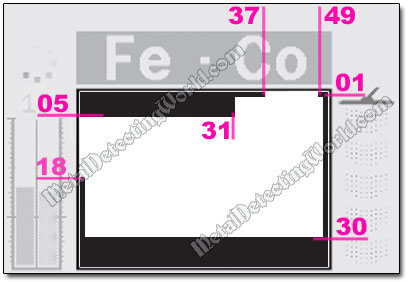
All rejected areas in CONDUCTIVITY area of the Smartfind (or Smartfind 2) window do not allow a metal detector to respond to iron falsing caused by the "Wrap Around Effect" (see description of this effect in my "E-Trac Field-Test Report" page 2). An accepted segment on the FE-01 line - a white gap extending from CO-38 to CO-48, allows for detection of large silver coins (in the US: Franklin Silver half, Kennedy Silver half, Peace Dollar, Eisenhower Dollar, and Morgan Dollar) and some old European copper coins of large sizes.
In FERROUS area of the window, the detector's responses to the iron falsing caused by the "wrap around effect" are blocked by the blackened CO-01 and CO-50 lines. Blackening entire area between the FE-30 and FE-35 lines changes the E-Trac's '4 TONE FERROUS' into 3 TONE FERROUS.
To create and edit the E-Trac's Discrimination Patterns, you need to use the E-Trac's Manual Edit Mode (see details on page 15 of my 3-Level "COINS" Search Program description, and on page 46 of the E-Trac Instruction Manual)
Even though the same Discrimination pattern and the '4-tone FE' audio setup are utilized on the CTX 3030, its Tone ID Profile can be modified more specifically. I resized the lower tone bin which now extends from the FE-22 line to FE-35 line. With this Tone ID Map, the distorted responses to coins and other desirable targets with their FE properties "landing" between the FE-17 and FE-23 lines will be of a higher tone pitch, and the '4-tone FE' Tone ID Map will not lose one tone. The responses to non-ferrous targets with their FE numbers reaching up to 27 (between the FE-23 and FE-27 lines) will be of the lowest tone pitch and should be investigated.
Minelab CTX-3030 Discrimination Pattern with "4-TONE FE" Tone ID Profile for "Farm Fields"
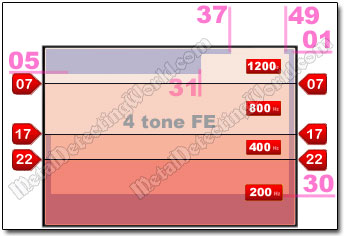
NOTE: You can assign an audio tone of any frequency you like to each bin. Experiment with different frequencies to make sure you can hear difference between two "neighboring" audio tones, and your hearing is comfortable with your selection. The tone frequencies shown in the Audio Setup above are NOT the exact actual frequencies. Each number only represents the frequency range assigned to a corresponding bin.
If you prefer a simpler Tone ID Profile, you can switch to 2 tone FE: a high tone pitch indicates non-ferrous targets, and the low tone pitch announces both iron and non-ferrous targets with their skewed FE values.
Minelab CTX-3030 Discrimination Pattern with "2-TONE FE" Tone ID Profile for "Farm Fields"
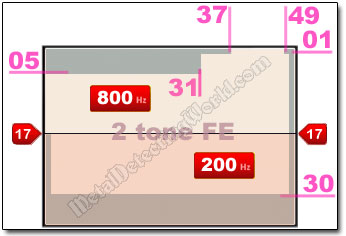
E-Trac's QUICKMASK and CTX 3030's 2nd DISCRIMINATION PATTERNS
You may want to read all information (usage and editing) about the E-Trac's QuickMask on page 12 of my 3-Level "COINS" Search Program description. Shown below is the QuickMask pattern which I use for all my search programs.
E-Trac's QuickMask Pattern for Search Program #2
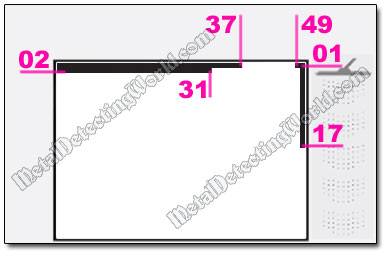
When operated in FERROUS SOUNDS and with "open screen" (NO Discrimination), the E-Trac's QuickMask does not make the iron junk "scream" like silver; however, I prefer to hear less iron falsing caused by the "wrap around effect" so I keep the FE-01 line blackened the same way as in the Discrimination pattern: keeping the "white" gap from CO-38 to CO-48 inclusively (shown above). The rest of rejected areas in this pattern also take care of the iron falsing. If I want to make the iron falsing a little quieter, sometimes I blacken the entire horizontal Fe-35 line on the bottom of the QuickMask window. The CO-50 line is blackened from FE-01 to the FE-17 inclusively to mute the detector's possible responses to hot rocks.
The QuickMask Discrimination pattern can be adjusted or edited using either the QuickMask screen itself (see details on page 12 of my 3-Level "COINS" Search Program description) or the Edit screen (see details on page 15 of my 3-Level "COINS" Search Program description).
The CTX 3030's 2nd Discrimination pattern of the current User Mode is used for the same reasons as the E-Trac's QuickMask (read all details about usage and editing of CTX's Pattern 2 (P2) on page 13 of my 3-Level "COINS" Search Program). Shown below is the CTX's Second Discrimination pattern without any Tone ID Profile. You can assign any Tone ID Map (see 3 most useful Tone ID Map types here) you want to this pattern if you create it in a different User Mode. Otherwise this pattern will be used with the Tone ID Profile (4-tone FE) of the current User Mode.
Minelab CTX-3030 Second Discrimination Pattern without Tone ID Map for Search Program #2
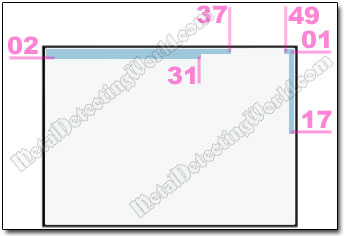
To edit any of two CTX 3030's Discrimination patterns - Pattern 1 (P1) or Pattern 2 (P2), of any Search mode, you can use either the CTX 3030's Control Panel (see details on page 16 of my 3-Level "COINS" Search Program description) or the Minelab XChange 2 application which makes it easier to do (see details on page 4 of my Tutorial - "How To Use XChange 2 for EDITING").
Please let me know your opinion on my program after you use it. You are welcome to submit some pictures of your finds recovered with my program. I would appreciate any suggestions, tips, and constructive criticism. If you have an effective search program for coin shooting in the fields, and you would like to share it with the community, please e-mail me your program! I would be happy to post it here. Good Luck and Happy Hunting!
Make a Donation
Please help me stay afloat, afford more metal detecting trips with field-tests and experiments to create more informative articles, useful tutorials and helpful guides for detectorists, and maintain this website - the most informative hobby resource on the web! Since I do not have any steady income, any donation matters to me a lot! Thank you kindly!
Clicking on the donate button will take you to a donation page powered by Donorbox and dedicated to my website (MetalDetectingWorld.com). The donation page is PCI-compliant, secured by SSL/TLS, and has a simple form to fill out. Donorbox does not store any card or bank data. Credit card information is encrypted and tokenized by the Stripe payment processor.
This website would not exist without the advertisements we display and your kind donations. If you are unable to support us by viewing our advertisements, please consider making a Donation to ensure the future of this website. By helping me keep this website alive and growing, you will sure help many detectorists around the world as well!
ANNOUNCEMENT:
In January of 2020, I started a one-time fund-raising campaign in attempt to accumulate enough money to buy a simple but reliable 4x4 vehicle. My old 4x4 car (made in 1995) had faithfully served me for 10 years before it eventually went beyond repair last October. Without a 4WD, I will not be able to get to my hunt sites and test-plots hidden in the remote wooded areas inaccessible by a regular car.
Unlucky for me, those sites are the only locations available and suitable for my field-work which results in informative articles you can find on this website. For the past 10 years, my usual field-work has consisted of field-testing the latest metal detectors and accessories, experimenting with some of them, and devising new effective search methods that meet the requirements of the new metal detecting reality.
Before my car died, I managed to finish a couple of interesting detector-testing projects which will be covered in my upcoming articles. But other equally important projects that I was working on were not completed and had to be postponed until the Spring 2020. I hope that this fund-raising campaign will help me get a decent 4x4 by then so that I will be able to resume my work and to write more new articles, tutorials and guides based on data gathered through testing and experimentation.
If you find my website useful and would like it to provide more essential info for you and other detectorists worldwide, please consider chipping in $5, $20, $50 or whatever you can afford to keep MetalDetectingWorld.com growing in 2020. I promise you, it will be money well spent. Thank you.
Donate- Please help me promote this article:
If you would like to follow me on Twitter, please press a button:
I have my profile page on
where you can share your thoughts on this article, ask me a question, or place a friend request.I also have my profile pages on Pinterest, LinkedIn, Tumblr, Reddit and Delicious
and my "Metal Detecting World" page on Twitter, Pinterest and Tumblr
I no longer maintain my old Facebook page